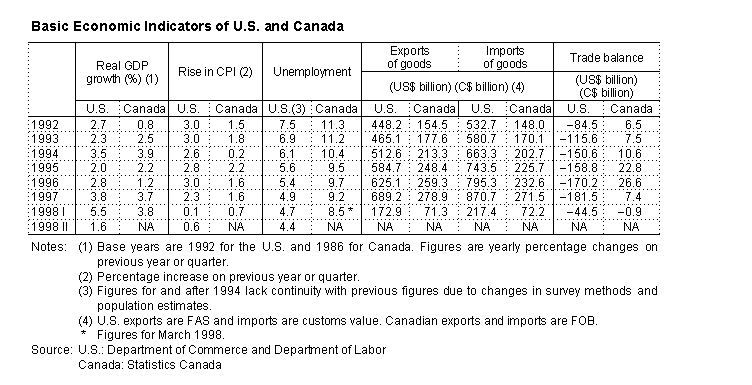
Japan External Trade Organization (JETRO)
A look at U.S. trade in goods in 1997 shows that despite the rise in the U.S. dollar, exports were up 10.3% on the previous year to US$689.2 billion, thanks mainly to strong demand for highly competitive capital goods in non-price terms, such as aircraft. Imports climbed 9.5% on the previous year to US$870.7 billion due to the fall in import prices resulting from the rise in the U.S. dollar and the firm tone of the U.S. economy due to strong personal consumption and housing investment. As a consequence, the U.S. trade deficit swelled 6.6% in 1997 to a record US$181.5 billion. Canadian exports in 1997, on the other hand, rose 7.6% on the previous year to C$278.9 billion, while imports rose 16.5% to C$271.5 billion, reflecting strong domestic demand. The Canadian trade surplus fell sharply by 72.3% to C$7.4 billion.
The Clinton administration continues to stress trade policy as a part of its comprehensive economic policy, and it is working to promote exports and open up global markets through multilateral and bilateral trade negotiations. The U.S. is not only opening up markets, but is also monitoring compliance with agreements on trade and is turning to dispute resolution through organizations such as the WTO if it finds that agreements are being insufficiently implemented. Canada's Chretien administration is working to liberalize trade in order to diversify export markets, with the focus of trade policy being on Asia and Latin America. Canada is strengthening its own foothold in Latin America without waiting for the U.S., where the road for the Clinton administration to obtain fast-track negotiating authority remains fogged.
U.S. exports to Japan in 1997 fell 3.1% year on year to US$65.5 billion
due to the effects of the prolonged slump in the Japanese economy. Reflecting
the buoyant state of the U.S. economy, however, imports were up 5.6% to
US$121.7 billion, and the trade deficit with Japan consequently began to
rise again, increasing 5.6% to US$56.1 billion. Due not only to the trade
deficit with Japan but also to Japan's late response to the Asian currency
and economic crisis, the Japanese government is facing growing calls from
the U.S. for it to encourage domestic demand-led recovery, and to deregulate
and open up the domestic market and reform the financial system. Canada's
exports to Japan fell 2.8% on the previous year to C$10.8 billion as a
result of the decline in exports of forest products-key exports to Japan-due
to the contraction in housing demand in Japan. Imports rose 19.8% to C$12.5
billion due to increased imports of automobiles and auto parts, and the
previous year's trade surplus turned into a C$1.7 billion deficit.
